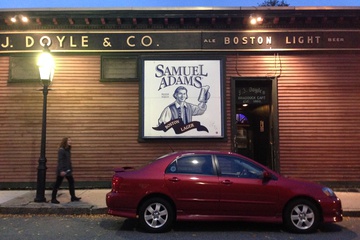1637: John Harvard moves from England to Massachusetts Bay Colony. He dies later that year, leaving money to New College, which is later renamed for its greatest benefactor. Harvard develops plans to build a brewery on its campus. Legend has it that Harvard learned the art of beer brewing from family friend William Shakespeare. One could say that the College’s on-campus brewery used recipes directly from the “First Folio.”*
1639: The first President of Harvard College, Nathaniel Eaton, leaves campus brewery functions to his wife, who lets supplies dwindle, much to the dissatisfaction of the students. Eaton subsequently loses his job.
1667: Harvard College enforces rules dictating how certain beers are brewed on campus.
1686: Increase Mather is appointed President of Harvard College, and updates College rules to stipulate a specific ratio of gallons of beer to barley malt to ensure the best possible brew for students.
1703: Harvard boasts three breweries on its campus. At Commencement, one barrel of cider is served along with four gallons of beer and 18 gallons of wine.
Late 1700s: As the institution focuses on promoting its academics, Harvard’s breweries fall largely out of function, and most of the beer is relegated to a storehouse.
1814: The last remaining brewery on Harvard’s campus succumbs to a fire.
1860s: 10,000 men of Harvard like to sing, and 10,000 men of Harvard like their beer. Rousing choruses from drinking songs include lyrics such as “For I like a drop o’ good beer,—I does; I’se fond of a drop o’ good beer, —I is,” and “For Sally likes her beer,—her does; Hur’s fond of a drop o’ good beer,—hur is!”
1892: The Hasty Pudding Theatricals’ 1892 Christmas Theatricals program lists the lyric, “We cannot recommend the mixture of beer, milk, maple syrup, and ice cream. Even an ostrich would hesitate.”
1917: Harvard’s Adolphus Busch Hall is completed. It is named for its benefactor, who also lent his name to the Anheuser-Busch Company, which today brews Budweiser beer.
January 1934: After over 100 years of dry dining and the end of the Prohibition era, beer is again served in the College dining halls for sudents over 21. In order to drink, students had to produce special blue cards signed by their House masters.
Decemer 1934: Having sold only 27,000 bottles in 10 months, the University discontinues the sale of beer in student dining halls due to lack of interest.
1964: Harvard introduces a bartending course for students. Open twice a month to over 100 students, the final exam consists of students sitting in a circle and creating drinks for the student to their right, until someone passes out. Tightened legislation has since cut this method of evaluation from the course.
1986: Harvard University students Rich Doyle ’82 and Dan Kenary ’82 found the Mass Bay Brewing Company, which today produces Harpoon beer.
2002: Harvard bans kegs at all sporting events, including the annual Harvard-Yale football game, in the hopes of reducing excessive alcohol consumption among spectators.
2004: The Harvard Beer Society is formed by undergraduates to unite beer connoisseurs. Matthew J. Kozlov ’04 successfully petitions the College to create an anthropology course entitled “Intoxicating Agents in Comparative and Historical Perspective.” Harvard University joins a campaign calling for the National College Athletic Association to eliminate alcohol advertisements from its broadcasting.
2007: Harvard implements its amnesty policy, which allows intoxicated students to be admitted to UHS without disciplinary consequences.
2008: Faust and over 100 other university presidents sign a letter to the NCAA, reprimanding its inclusion of 270 seconds of beer commercials during its telecast of the March Madness telecast game. The NCAA guidelines then limited beer commercials to 120 seconds.
2012: Harvard releases new College-wide alcohol policies which standardized how alcohol can be handled everywhere on campus, from dorm rooms to social events.
*Information from “Historic Taverns of Boston: 370 Years of Tavern History in One Definitive Guide” by Gavin Nathan.



